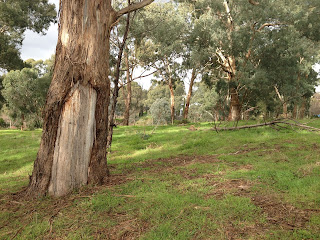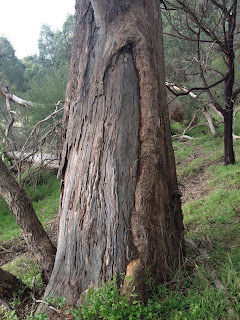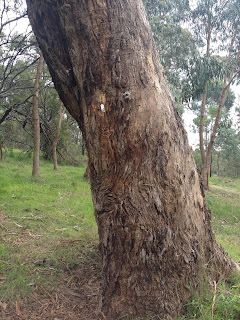Scar trees on the Mullum Mullum Creek in Melbourne's east
Today - a ride up the Mullum Mullum Creak to where it meets the Yarra River (Birrarung). This is Tikalara Park, a special place for the Wurrundjeri as the sign says (below). Also, the first place where a white settler built a homestead in 1837...soon to force out the locals who lived on the high ground above the floodplains:
Some local websites seem to treat the Indigenous history in a pretty short manner, as in: http://bobpadula.wixsite.com/yarraparklands/tikalara-park, where the main mention is as follows:
"The property itself (now subdivided) has several remnant plantings of the colonial era, including Himalayan Cypress, Black Mulberry and willow trees and the integrity of ancient scar trees, ancestral camping sites and other spirit places of the Wurundjeri aborigines, which was respected by the Newman family."
Another online source offers other perspectives on settler Major Charles Newman's relationship to the locals:
Major Newman was also harsh on the local natives who constantly set fires in his paddocks and property. He insisted that his employees be armed and use their weapons against the natives. To get even for the harsh treatment a group of these local natives ascended onto his homestead armed with spears with the intent of killing him. Catherine hid him in the chimney and eventually the natives went away. On coming out of the chimney, the story goes, that he was singed and all black and covered with with soot.
(http://freepages.genealogy.rootsweb.ancestry.com/~hanhorg/bio/newman/newman_charles_0995-01.html)
Then, riding back down the track following the Mullum Mullum, I spy this to the right:
A look up the hillside - a raised area above the flatlands that now has a big brick house above - reveals many other scarred trees. A mob of big red kangaroos look on as I walk around. More and more, I think this might have been one of the semi-permanent places where the bark huts were. Some of the scars have zig-zag saw tooth impressions, suggesting that they had their bark removed post-colonial settlement.
I notice that every tree in these parts is tagged:
I leave the special place and keep riding. A couple of minutes down the track, I see another scar and stop to take snaps (below). A white bloke walking by asks me if this might be a 'canoe tree'. We have a long chat about the scar trees and the history of the area. He wants to take his three kids to see the scar trees and explain their history- they've already explored around the homestead and learned sbout the potted and difficult history of the area. There's hope for this country yet.
Some local websites seem to treat the Indigenous history in a pretty short manner, as in: http://bobpadula.wixsite.com/yarraparklands/tikalara-park, where the main mention is as follows:
"The property itself (now subdivided) has several remnant plantings of the colonial era, including Himalayan Cypress, Black Mulberry and willow trees and the integrity of ancient scar trees, ancestral camping sites and other spirit places of the Wurundjeri aborigines, which was respected by the Newman family."
Another online source offers other perspectives on settler Major Charles Newman's relationship to the locals:
Major Newman was also harsh on the local natives who constantly set fires in his paddocks and property. He insisted that his employees be armed and use their weapons against the natives. To get even for the harsh treatment a group of these local natives ascended onto his homestead armed with spears with the intent of killing him. Catherine hid him in the chimney and eventually the natives went away. On coming out of the chimney, the story goes, that he was singed and all black and covered with with soot.
(http://freepages.genealogy.rootsweb.ancestry.com/~hanhorg/bio/newman/newman_charles_0995-01.html)
Then, riding back down the track following the Mullum Mullum, I spy this to the right:
A look up the hillside - a raised area above the flatlands that now has a big brick house above - reveals many other scarred trees. A mob of big red kangaroos look on as I walk around. More and more, I think this might have been one of the semi-permanent places where the bark huts were. Some of the scars have zig-zag saw tooth impressions, suggesting that they had their bark removed post-colonial settlement.
I notice that every tree in these parts is tagged:
I leave the special place and keep riding. A couple of minutes down the track, I see another scar and stop to take snaps (below). A white bloke walking by asks me if this might be a 'canoe tree'. We have a long chat about the scar trees and the history of the area. He wants to take his three kids to see the scar trees and explain their history- they've already explored around the homestead and learned sbout the potted and difficult history of the area. There's hope for this country yet.
We part ways, and further down, dotted along the creek are a few more I hadn't seen at all on the way up. Quite the exciting day:


































































Comments
Post a Comment